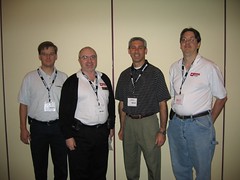If you've been waiting (and waiting) for Microsoft to provide a way to package and deploy solutions you've developed for Microsoft Access 2007, then the wait is now officially over. According to Eric Rucker, one of the bloggers/developers at Microsoft working on future versions of the perennial developer favorite, the developer extensions and runtime version are available as of 25-Jun-2007.
If you don't need to read about it directly, then here are the links for the downloads:
Another resource worth considering is MSMVPS.COM: The Ultimate Destination for Blogs by Current and Former Microsoft Most Valuable Professionals. Tony Toews was the first off the mark to comment on the release (although the problem he reported with one link not working seems already to have been resolved).
A few other bloggers noting this event:
Blake Handler: The Road To Know Where
Clint Covington: Software Design, Microsoft Office Access
Alex Dybenko: Alex & Access
"AccessJunkie" of the MDBMakers.com (A Microsoft Access Developers Help Group)
So, it's time for me to gear up and determine once and for all whether I'll continue to develop in Access 2007. I've been having some doubts...until I downloaded and installed Office 2007, saw the new interface, and picked up my copy of Access 2007 VBA Programmer's Reference. At a wrist-bending 1152 pages, this hefty tome with 4 major Access authors contributing sparked my interest once again. Clearly, the new product offers more than I anticipated, despite some of the fall off among Access MVPs over the past few years.
Expect to see a few more entries on this blog about Access 2007 in the near future.





